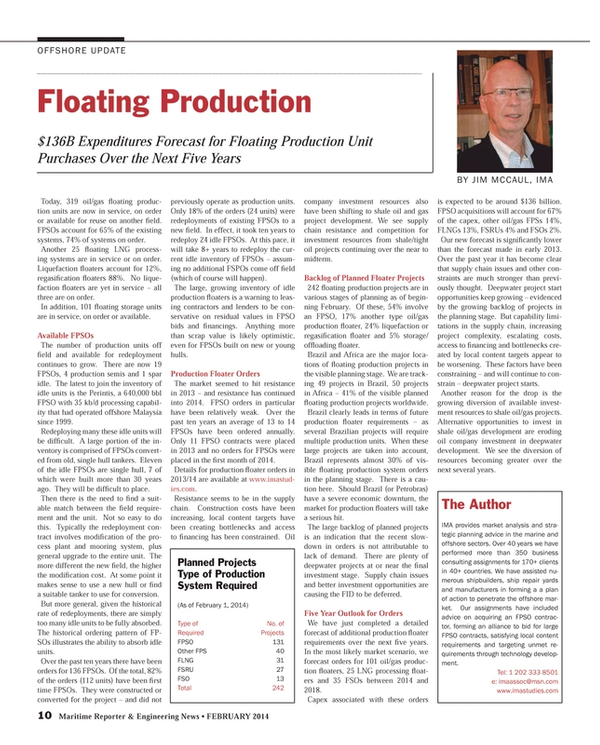
Floating Production Market Forecast
$136 billion expenditures forecast for Floating Production Unit purchases over the next five years
Today, 319 oil/gas floating production units are now in service, on order or available for reuse on another field. FPSOs account for 65% of the existing systems, 74% of systems on order.
Another 25 floating LNG processing systems are in service or on order. Liquefaction floaters account for 12%, regasification floaters 88%. No liquefaction floaters are yet in service – all three are on order.
In addition, 101 floating storage units are in service, on order or available.
Available FPSOs
The number of production units off field and available for redeployment continues to grow. There are now 19 FPSOs, four production semis and one spar idle. The latest to join the inventory of idle units is the Perintis, a 640,000 bbl FPSO with 35 kb/d processing capability that had operated offshore Malaysia since 1999.
Redeploying many these idle units will be difficult. A large portion of the inventory is comprised of FPSOs converted from old, single hull tankers. Eleven of the idle FPSOs are single hull, seven of which were built more than 30 years ago. They will be difficult to place.
Then there is the need to find a suitable match between the field requirement and the unit. Not so easy to do this.Typically the redeployment contract involves modification of the process plant and mooring system, plus general upgrade to the entire unit. The more different the new field, the higher the modification cost. At some point it makes sense to use a new hull or find a suitable tanker to use for conversion.
But more general, given the historical rate of redeployments, there are simply too many idle units to be fully absorbed. The historical ordering pattern of FPSOs illustrates the ability to absorb idle units.
Over the past 10 years there have been orders for 136 FPSOs. Of the total, 82% of the orders (112 units) have been first time FPSOs. They were constructed or converted for the project – and did not previously operate as production units. Only 18% of the orders (24 units) were redeployments of existing FPSOs to a new field. In effect, it took ten years to redeploy 24 idle FPSOs. At this pace, it will take eight-plus years to redeploy the current idle inventory of FPSOs – assuming no additional FSPOs come off field (which of course will happen).
The large, growing inventory of idle production floaters is a warning to leasing contractors and lenders to be conservative on residual values in FPSO bids and financings. Anything more than scrap value is likely optimistic, even for FPSOs built on new or young hulls.
Production Floater Orders
The market seemed to hit resistance in 2013 – and resistance has continued into 2014. FPSO orders in particular have been relatively weak. Over the past 10 years, an average of 13-14 FPSOs have been ordered annually. Only 11 FPSO contracts were placed in 2013 and no orders for FPSOs were placed in the first month of 2014.
Details for production floater orders in 2013/14 are available at www.imastudies.com.
Resistance seems to be in the supply chain. Construction costs have been increasing, local content targets have been creating bottlenecks and access to financing has been constrained. Oil company investment resources also have been shifting to shale oil and gas project development. We see supply chain resistance and competition for investment resources from shale/tight oil projects continuing over the near to midterm.
Backlog of Planned Floater Projects
242 floating production projects are in various stages of planning as of beginning February. Of these, 54% involve an FPSO, 17% another type oil/gas production floater, 24% liquefaction or regasification floater and 5% storage/offloading floater.
Brazil and Africa are the major locations of floating production projects in the visible planning stage. We are tracking 49 projects in Brazil, 50 projects in Africa – 41% of the visible planned floating production projects worldwide.
Brazil clearly leads in terms of future production floater requirements – as several Brazilian projects will require multiple production units. When these large projects are taken into account, Brazil represents almost 30% of visible floating production system orders in the planning stage. There is a caution here. Should Brazil (or Petrobras) have a severe economic downturn, the market for production floaters will take a serious hit.
The large backlog of planned projects is an indication that the recent slowdown in orders is not attributable to lack of demand. There are plenty of deepwater projects at or near the final investment stage. Supply chain issues and better investment opportunities are causing the FID to be deferred.
Five Year Outlook for Orders
We have just completed a detailed forecast of additional production floater requirements over the next five years. In the most likely market scenario, we forecast orders for 101 oil/gas production floaters, 25 LNG processing floaters and 35 FSOs between 2014 and 2018.
Capex associated with these orders is expected to be around $136 billion. FPSO acquisitions will account for 67% of the capex, other oil/gas FPSs 14%, FLNGs 13%, FSRUs 4% and FSOs 2%.
Our new forecast is significantly lower than the forecast made in early 2013. Over the past year it has become clear that supply chain issues and other constraints are much stronger than previously thought. Deepwater project start opportunities keep growing – evidenced by the growing backlog of projects in the planning stage. But capability limitations in the supply chain, increasing project complexity, escalating costs, access to financing and bottlenecks created by local content targets appear to be worsening. These factors have been constraining – and will continue to constrain – deepwater project starts.
Another reason for the drop is the growing diversion of available investment resources to shale oil/gas projects. Alternative opportunities to invest in shale oil/gas development are eroding oil company investment in deepwater development. We see the diversion of resources becoming greater over the next several years.
Planned Projects
Type of Production
System Required
(As of February 1, 2014)
Type of No. of
Required Projects
FPSO 131
Other FPS 40
FLNG 31
FSRU 27
FSO 13
Total 242
The Author
IMA provides market analysis and strategic planning advice in the marine and offshore sectors. Over 40 years we have performed more than 350 business consulting assignments for 170-plus clients in 40-plus countries. We have assisted numerous shipbuilders, ship repair yards and manufacturers in forming a a plan of action to penetrate the offshore market. Our assignments have included advice on acquiring an FPSO contractor, forming an alliance to bid for large FPSO contracts, satisfying local content requirements and targeting unmet requirements through technology development.
Tel: 1 202 333 8501
e: [email protected]
www.imastudies.com
(As published in the February 2014 edition of Maritime Reporter & Engineering News - www.marinelink.com)
Read Floating Production Market Forecast in Pdf, Flash or Html5 edition of February 2014 Maritime Reporter
Other stories from February 2014 issue
Content
- Something Old, Something New ... page: 06
- Floating Production Market Forecast page: 10
- The FLNG Market is Poised for Growth page: 12
- Managing BWT Costs and Compliance page: 14
- U.S. Coast Guard Must Assert its Authority page: 16
- Transferring Risk for Long-term Success page: 18
- You Can Run, But You Can’t Hide page: 24
- Cruise Industry Poised for Global Growth page: 26
- MIOX Safe Water Management for Cruise Ships page: 28
- Five Minutes With Tomas Tillberg page: 30
- SS United States: Leading Lady to Damsel in Distress page: 32
- Alfa Laval: Green & Efficient Shipping page: 42
- Oily Wastewater Transformed with WETT-O page: 45
- Siemens System Controls Filter Biofouling page: 46
- New BWM Regs Cometh - Are you ready? page: 46
- Valve Train Halves Idle to Full Load Time page: 48
- Unmanned Ships Now a Reality page: 49
- Five Minutes with WSS's Simon Hutt page: 50
- Hempel Debuts Hempaguard page: 54
- Ecofix Corrosion Repair with Ecoshield Application page: 54
- Envelop Protective Covers page: 55
- GAC Launches Eco-friendly Hull Cleaning Solution page: 56
- CS Unitec Debuts Trelawny Floor Planer page: 56
- New Hatch Sealing Tape page: 57
- New Aluminum Vise Action Compression Latch page: 57
- High Strength, Vibration Resistant Fastener from Huck page: 57
- Gumdrop Debuts Cases for Marine Industry page: 57
- New Handheld Marking System FlyMarker PRO page: 57
- Viking Refits Four NGSCO Vessels with LRRS System page: 57
- DNV GL Debuts New Explosion Hazard Software page: 57
- Handy, Quick Legionella Tests for Cruise Ships page: 58
- AMSOIL Introduces New Arctic Synthetic Grease page: 58
- Clean Marine to Supply EGCS for Tanker Newbuilds page: 58
- Engineered Ventilation Systems Keep Engine Rooms Humming page: 58
- New FARO Laser Scanner Focus3D X 33 page: 58


